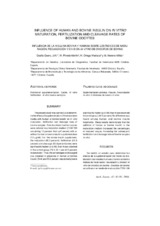Mostrar el registro sencillo del ítem
Influence of human and bovine insulin on in vitro maturation, fertilization and cleavage rates of bovine oocytes
| dc.contributor.author | Ortega Mariscal, M.A. | es_ES |
| dc.contributor.author | Pinedo Merlín, M. | es_ES |
| dc.contributor.author | Ocaña Quero, J.M. | es_ES |
| dc.contributor.author | Moreno-Millán, M. | |
| dc.date.accessioned | 2010-05-19T17:53:33Z | |
| dc.date.available | 2010-05-19T17:53:33Z | |
| dc.date.issued | 1998 | |
| dc.identifier.issn | 1885-4494 | |
| dc.identifier.uri | http://hdl.handle.net/10396/3372 | |
| dc.description.abstract | The present study was carried out to determine the effects of supplementation of the maturation media with human or bovine insulin on in vitro maturation, fertilization and cleavage rates of bovine oocytes. Cumulus-intact bovine oocytes were cultured in a maturation medium (TCM-199 containing 10 percent fetal calf serum) with or without human or bovine insulin supplementation (10 mg/ml). For the bovine insulin supplement, the maturation (80.3 percent), fertilization (61.3 percent) and cleavage (55.3 percent) rates were significantly higher (p<0.05) than those obtained in the control group (70.1; 50.1 and 42.5 percent respectively). Thus, the percentages of cleavaged ova obtained in presence of human or bovine insulin (54.8 and 55.3 percent respectively) were significantly higher (p<0.05) than those observed in control group (42.5 percent). No difference was found among human and bovine insulin treatments. These results demonstrate that the addition of human or bovine insulin to the maturation medium increased the percentages of matured oocyte, increasing the subsequent fertilization and cleavage rates of bovine oocytes in vitro. | en |
| dc.description.abstract | Se realizó un estudio para determinar los efectos de la suplementación del medio de maduración con insulina humana o bovina sobre los índices de maduración, fecundación y división in vitro de ovocitos de bovino. Ovocitos de bovino se cultivaron en medio de maduración (TCM-199 conteniendo 10 p.100 de suero de ternero fetal) con o sin insulina humana o bovina (10 mg/ml). Para la insulina bovina, los índices de maduración (80,3 p.100), fecundación (61,3 p.100) y división (55,3 p.100) fueron superiores significativamente (p<0,05) que aquellos obtenidos por el grupo control (70,1; 50,1 y 42,5 p.100 respectivamente). Además, los porcentajes de óvulos divididos obtenidos en presencia de insulina humana o bovina (54,8 y 55,3 p.100 respectivamente), fueron superiores significativamente (p<0,05) en comparación con los obtenidos por el grupo control (42,5 p.100). No se apreciaron diferencias significativas entre los tratamientos con insulina humana y bovina. Estos resultados ponen de manifiesto que la adición de insulina humana o bovina al medio de maduración incrementa los porcentajes de ovocitos maduros, mejorando posteriormente los índices de fecundación y división de ovocitos de bovino in vitro. | es_ES |
| dc.format.mimetype | application/pdf | es_ES |
| dc.language.iso | eng | es_ES |
| dc.publisher | Universidad de Córdoba, Servicio de Publicaciones | es_ES |
| dc.rights | https://creativecommons.org/licenses/by-nc-nd/4.0/ | es_ES |
| dc.source | Archivos de zootecnia 47 (177), 85-93 (1998) | es_ES |
| dc.subject | Suplementación proteica | es_ES |
| dc.subject | Maduración in vitro | es_ES |
| dc.subject | Fecundación in vitro | es_ES |
| dc.subject | Ganado bovino | es_ES |
| dc.title | Influence of human and bovine insulin on in vitro maturation, fertilization and cleavage rates of bovine oocytes | en |
| dc.title.alternative | Influencia de la insulina bovina y humana sobre los índices de maduración, fecundación y división in vitro de ovocitos de bovino | es_ES |
| dc.type | info:eu-repo/semantics/article | es_ES |
| dc.relation.publisherversion | http://www.uco.es/organiza/servicios/publica/az/az.htm | es_ES |
| dc.rights.accessRights | info:eu-repo/semantics/openAccess | es_ES |

